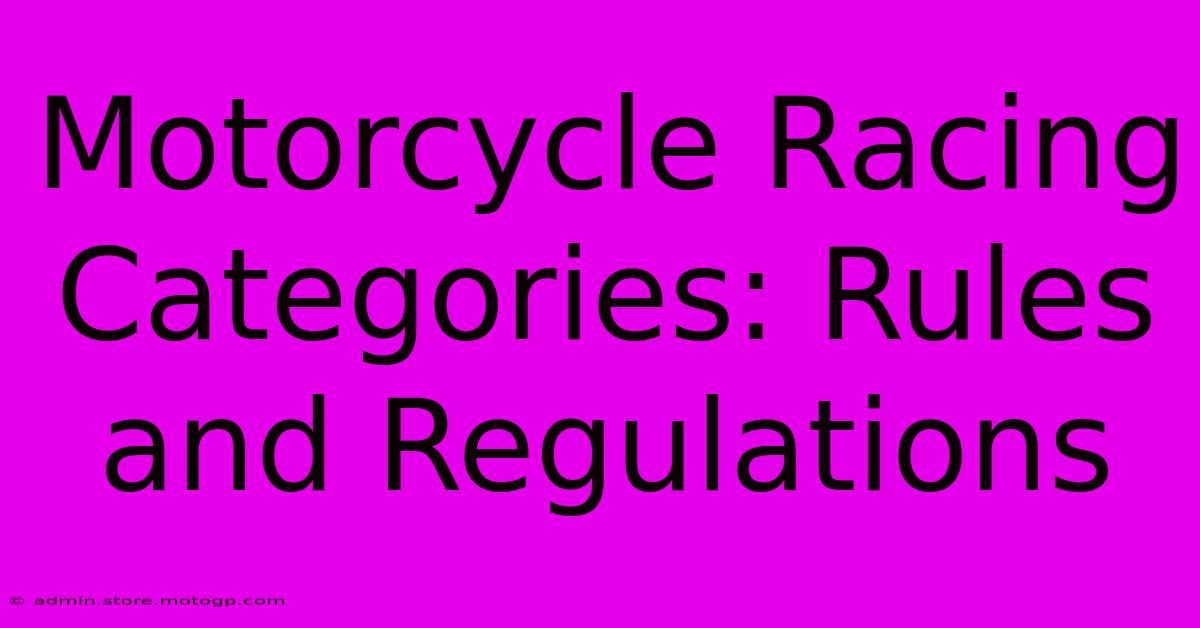Motorcycle Racing Categories: Rules And Regulations

Table of Contents
Motorcycle Racing Categories: Rules and Regulations
Motorcycle racing is a thrilling spectacle, but the diverse range of categories can be confusing for newcomers. This comprehensive guide breaks down the major motorcycle racing categories, outlining their key rules and regulations. Understanding these differences is crucial for appreciating the nuances and challenges faced by racers in each class.
Major Motorcycle Racing Categories
Several governing bodies oversee different racing series, each with its own set of rules and regulations. However, some common categories transcend these organizations:
1. MotoGP (Grand Prix Motorcycle Racing)
MotoGP is the pinnacle of motorcycle road racing. This category features the fastest and most technologically advanced prototypes, boasting powerful engines and sophisticated aerodynamics.
Rules and Regulations: The FIM (Fédération Internationale de Motocyclisme) governs MotoGP, with strict regulations on engine capacity (currently 1000cc), electronics, and safety features. Teams meticulously follow technical specifications to ensure fair competition. Race weekends are structured with practice sessions, qualifying, and the main race, all crucial for points accumulation and championship standings. Safety is paramount, with stringent rider safety gear requirements and track marshaling protocols.
Key Features: High speeds, intense competition, and cutting-edge technology define MotoGP. The races are long and demanding, requiring riders to possess exceptional skill, stamina, and bike control.
2. Moto2
Moto2 serves as a stepping stone to MotoGP. All riders compete on identical purpose-built machines using a single engine supplier, which levels the playing field and emphasizes rider skill.
Rules and Regulations: The focus is on equal machinery, allowing riders to showcase their talent without the vast discrepancies in technology seen in MotoGP. Strict regulations govern engine specifications, chassis design, and other key components. Similar to MotoGP, safety regulations are rigorously enforced.
Key Features: Close racing, intense battles for position, and the opportunity to witness future MotoGP stars make their mark.
3. Moto3
Moto3 is the entry-level class in the Grand Prix motorcycle racing world championship. Riders compete on smaller-capacity bikes (250cc), fostering intense competition and rapid progression.
Rules and Regulations: Similar to Moto2, the regulations emphasize cost-effectiveness and equal opportunity. The focus remains on rider skill and talent development. Engine specifications, chassis parameters, and safety equipment are tightly controlled.
Key Features: Aggressive racing, a high number of overtaking maneuvers, and a showcase of young and rising stars in the sport.
4. Superbike World Championship (WSBK)
Unlike MotoGP's prototypes, WSBK features production-based motorcycles modified for racing. This category emphasizes the accessibility of racing technology to the general public.
Rules and Regulations: The rules allow manufacturers to showcase their production models' performance potential, with modifications within certain parameters. The regulations balance performance with safety and affordability.
Key Features: Closer relationship with commercially available motorcycles, creating a connection between racing technology and street machines.
5. Other Notable Categories
Many other motorcycle racing categories exist globally, catering to various levels of competition and machine types. These include:
- Supersport: Similar to Superbike but with less powerful machines.
- Superstock: Near-production motorcycles with minimal modifications.
- Road Racing: Races held on public roads, often featuring classic motorcycles.
- Flat Track: Dirt track racing with oval tracks and unique riding styles.
- Motocross: Off-road racing on challenging terrain.
Safety Regulations Across Categories
Regardless of the racing category, safety regulations are paramount. These typically include:
- Mandatory safety gear: Helmets, leathers, boots, gloves, and back protectors.
- Track safety measures: Run-off areas, barriers, and medical facilities.
- Technical inspections: Regular checks of motorcycles to ensure they meet safety standards.
- Race control: Monitoring races for safety violations and taking appropriate action.
Conclusion
The world of motorcycle racing encompasses a vast array of categories, each with its own set of unique rules and regulations. Understanding these differences is key to appreciating the sport's complexity and the incredible skill of its participants. From the cutting-edge technology of MotoGP to the production-based machines of WSBK, each category offers its own brand of excitement and competitive spirit. The emphasis on safety, though, remains constant across all levels of competition, ensuring that the thrill of the race is balanced with the well-being of the riders.

Thank you for visiting our website wich cover about Motorcycle Racing Categories: Rules And Regulations. We hope the information provided has been useful to you. Feel free to contact us if you have any questions or need further assistance. See you next time and dont miss to bookmark.
Featured Posts
-
Cota Merch The Perfect Souvenir From Austin
Feb 20, 2025
-
Moto 3 Motorcycle The Art Of Motorcycle Racing
Feb 20, 2025
-
Lub Si Cota Creating Lasting Change
Feb 20, 2025
-
The Greatest Moto Gp Rider Breaking Barriers
Feb 20, 2025
-
Unforgettable Moto Gp Tracks To Add To Your Bucket List
Feb 20, 2025
